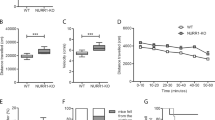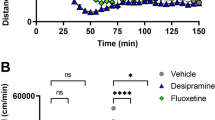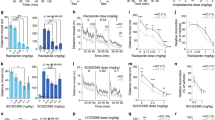Abstract
Rationale
Psychostimulants such as amphetamine and methylphenidate, which target the dopamine transporter (DAT), are the most frequently used drugs for the treatment of hyperactivity and cognitive deficits in humans with attention deficit hyperactivity disorder (ADHD). While psychostimulants can increase activity in healthy subjects, they exert a “paradoxical” calming effect in humans with ADHD as well as in hyperactive mice lacking the dopamine transporter (DAT-KO mice). However, the mechanism of action of these drugs and their impact on cognition in the absence of DAT remain poorly understood.
Objectives
This study was conducted to investigate the effects of psychostimulants and noradrenergic and serotonergic drugs on cognition in DAT-KO mice and normal (WT) littermates.
Methods
We used a recently developed behavioral apparatus, the automated H-maze. The H-maze involves the consecutive learning of three different rules: delayed alternation, nonalternation, and reversal tasks.
Results
Treatment of WT animals with the psychostimulants replicated the behavior observed in untreated DAT-KO mice while “paradoxically” restoring cognitive performances in DAT-KO mice. Further investigation of the potential involvement of other monoamine systems in the regulation of cognitive functions showed that the norepinephrine transporter blocker atomoxetine restored cognitive performances in DAT-KO mice without affecting hyperactivity. In contrast, the nonselective serotonin receptor agonist 5CT, which antagonizes hyperactivity in DAT-KO mice, had no effect on cognitive functions.
Conclusions
Taken together, these data allow dissociation of the locomotor and cognitive effects of ADHD drugs and suggest that the combination of DAT-KO mice with the automated H-maze can constitute a powerful experimental paradigm for the preclinical development of therapeutic approaches for ADHD.





Similar content being viewed by others
References
Advokat C, Scheithauer M (2013) Attention-deficit hyperactivity disorder (ADHD) stimulant medications as cognitive enhancers. Front Neurosci.7: Print 2013
Amara SG, Kuhar MJ (1993) Neurotransmitter transporters: recent progress. Annu Rev Neurosci 16:73–93
Arime Y, Kubo Y, Sora I (2011) Animal models of attention-deficit/hyperactivity disorder. Biol Pharm Bull 34:1373–1376
Arnsten AF, Pliszka SR (2011) Catecholamine influences on prefrontal cortical function: relevance to treatment of attention deficit/hyperactivity disorder and related disorders. Pharmacol Biochem Behav 99:211–216
Balint S, Czobor P, Meszaros A, Simon V, Bitter I (2008) Neuropsychological impairments in adult attention deficit hyperactivity disorder: a literature review. Psychiatr Hung 23:324–335
Bari A, Eagle DM, Mar AC, Robinson ES, Robbins TW (2009) Dissociable effects of noradrenaline, dopamine, and serotonin uptake blockade on stop task performances in rats. Psychopharmacology (Berl) 205:273–283
Barkley RA (1998) Attention-deficit hyperactivity disorder. Sci Am 279:66–71
Barnes JJ, Dean AJ, Nandam LS, O'Connell RG, Bellgrove MA (2011) The molecular genetics of executive function: role of monoamine system genes. Biol Psychiatry 69:e127–e143
Beaulieu JM, Sotnikova TD, Yao WD, Kockeritz L, Woodgett JR, Gainetdinov RR, Caron MG (2004) Lithium antagonizes dopamine-dependent behaviors mediated by an AKT/glycogen synthase kinase 3 signaling cascade. Proc Natl Acad Sci U S A 101:5099–5104
Beaulieu JM, Sotnikova TD, Gainetdinov RR, Caron MG (2006) Paradoxical striatal cellular signaling responses to psychostimulants in hyperactive mice. J Biol Chem 281:32072–32080
Bedard AC, Ickowicz A, Logan GD, Hogg-Johnson S, Schachar R, Tannock R (2003) Selective inhibition in children with attention-deficit hyperactivity disorder off and on stimulant medication. J Abnorm Child Psychol 31:315–327
Bolden-Watson C, Richelson E (1993) Blockade by newly-developed antidepressants of biogenic amine uptake into rat brain synaptosomes. Life Sci 52:1023–1029
Bossé R, Fumagalli F, Jaber M, Giros B, Gainetdinov RR, Wetsel WC, Missale C, Caron MG (1997) Anterior pituitary hypoplasia and dwarfism in mice lacking the dopamine transporter. Neuron 19:127–138
Bradley WE, Raelson JV, Dubois DY, Godin E, Fournier H, Prive C, Allard R, Pinchuk V, Lapalme M, Paulussen RJ, Belouchi A (2010) Hotspots of large rare deletions in the human genome. PLoS One 5:e9401
Breton-Provencher V, Lemasson M, Peralta MR 3rd, Saghatelyan A (2009) Interneurons produced in adulthood are required for the normal functioning of the olfactory bulb network and for the execution of selected olfactory behaviors. J Neurosci 29:15245–15257
Bushe CJ, Savill NC (2013) Systematic review of atomoxetine data in childhood and adolescent attention-deficit hyperactivity disorder 2009–2011: focus on clinical efficacy and safety. J Psychopharmacol. doi:10.1177/0269881113478475
Bymaster FP, Katner JS, Nelson DL, Hemrick-Luecke SK, Threlkeld PG, Heiligenstein JH, Morin SM, Gehlert DR, Perry KW (2002) Atomoxetine increases extracellular levels of norepinephrine and dopamine in prefrontal cortex of rat: a potential mechanism for efficacy in attention deficit/hyperactivity disorder. Neuropsychopharmacology 27:699–711
Chamberlain SR, Robbins TW, Sahakian BJ (2007) The neurobiology of attention-deficit/hyperactivity disorder. Biol Psychiatry 61:1317–1319
Chess S (1960) Diagnosis and treatment of the hyperactive child. N Y State J Med 60:2379–2385
Clemett DA, Punhani T, Duxon MS, Blackburn TP, Fone KC (2000) Immunohistochemical localisation of the 5-HT2C receptor protein in the rat CNS. Neuropharmacology 39:123–132
Contini V, Rovaris DL, Victor MM, Grevet EH, Rohde LA, Bau CH (2013) Pharmacogenetics of response to methylphenidate in adult patients with attention-deficit/hyperactivity disorder (ADHD): a systematic review. Eur Neuropsychopharmacol 23(6):555–560
Cubillo A, Smith AB, Barrett N, Giampietro V, Brammer MJ, Simmons A, Rubia K (2013) Shared and drug-specific effects of atomoxetine and methylphenidate on inhibitory brain dysfunction in medication-naive ADHD boys. Cereb Cortex (in press)
Cyr M, Beaulieu JM, Laakso A, Sotnikova TD, Yao WD, Bohn LM, Gainetdinov RR, Caron MG (2003) Sustained elevation of extracellular dopamine causes motor dysfunction and selective degeneration of striatal GABAergic neurons. Proc Natl Acad Sci U S A 100:11035–11040
Del'Guidice T, Nivet E, Escoffier G, Baril N, Caverni JP, Roman FS (2009) Perseveration related to frontal lesion in mice using the olfactory H-maze. Behav Brain Res 205:226–233
Douglas VI, Barr RG, Desilets J, Sherman E (1995) Do high doses of stimulants impair flexible thinking in attention-deficit hyperactivity disorder? J Am Acad Child Adolesc Psychiatry 34:877–885
Gainetdinov RR (2008) Dopamine transporter mutant mice in experimental neuropharmacology. Naunyn Schmiedebergs Arch Pharmacol 377:301–313
Gainetdinov RR, Caron MG (2001) Genetics of childhood disorders: XXIV. ADHD, part 8: hyperdopaminergic mice as an animal model of ADHD. J Am Acad Child Adolesc Psychiatry 40:380–382
Gainetdinov RR, Wetsel WC, Jones SR, Levin ED, Jaber M, Caron MG (1999) Role of serotonin in the paradoxical calming effect of psychostimulants on hyperactivity. Science 283:397–401
Gingerich KJ, Turnock P, Litfin JK, Rosen LA (1998) Diversity and attention deficit hyperactivity disorder. J Clin Psychol 54:415–426
Giros B, Caron MG (1993) Molecular characterization of the dopamine transporter. Trends Pharmacol Sci 14:43–49
Giros B, Jaber M, Jones SR, Wightman RM, Caron MG (1996) Hyperlocomotion and indifference to cocaine and amphetamine in mice lacking the dopamine transporter. Nature 379:606–612
Hammerness P, McCarthy K, Mancuso E, Gendron C, Geller D (2009) Atomoxetine for the treatment of attention-deficit/hyperactivity disorder in children and adolescents: a review. Neuropsychiatr Dis Treat 5:215–226
Han DD, Gu HH (2006) Comparison of the monoamine transporters from human and mouse in their sensitivities to psychostimulant drugs. BMC Pharmacol 6:6
Hannestad J, Gallezot JD, Planeta-Wilson B, Lin SF, Williams WA, van Dyck CH, Malison RT, Carson RE, Ding YS (2010) Clinically relevant doses of methylphenidate significantly occupy norepinephrine transporters in humans in vivo. Biol Psychiatry 68:854–860
Hechtman L (1994) Genetic and neurobiological aspects of attention deficit hyperactive disorder: a review. J Psychiatry Neurosci 19:193–201
Hironaka N, Ikeda K, Sora I, Uhl GR, Niki H (2004) Food-reinforced operant behavior in dopamine transporter knockout mice: enhanced resistance to extinction. Ann N Y Acad Sci 1025:140–145
Homberg JR (2012) Serotonin and decision making processes. Neurosci Biobehav Rev 36:218–236
Idris NF, Repeto P, Neill JC, Large CH (2005) Investigation of the effects of lamotrigine and clozapine in improving reversal-learning impairments induced by acute phencyclidine and D-amphetamine in the rat. Psychopharmacology (Berl) 179:336–348
Jensen NH, Cremers TI, Sotty F (2010) Therapeutic potential of 5-HT2C receptor ligands. SciWorld J 10:1870–1885
Jones SR, Gainetdinov RR, Wightman RM, Caron MG (1998) Mechanisms of amphetamine action revealed in mice lacking the dopamine transporter. J Neurosci 18:1979–1986
Koda K, Ago Y, Cong Y, Kita Y, Takuma K, Matsuda T (2010) Effects of acute and chronic administration of atomoxetine and methylphenidate on extracellular levels of noradrenaline, dopamine and serotonin in the prefrontal cortex and striatum of mice. J Neurochem 114:259–270
Kosheleff AR, Rodriguez D, O'Dell SJ, Marshall JF, Izquierdo A (2012) Comparison of single-dose and extended methamphetamine administration on reversal learning in rats. Psychopharmacology (Berl) 224:459–467
Lucke JC, Bell SK, Partridge BJ, Hall WD (2011) Academic doping or Viagra for the brain? The history of recreational drug use and pharmacological enhancement can provide insight into these uses of neuropharmaceuticals. EMBO Rep 12:197–201
Maziade M, Rouleau N, Lee B, Rogers A, Davis L, Dickson R (2009) Atomoxetine and neuropsychological function in children with attention-deficit/hyperactivity disorder: results of a pilot study. J Child Adolesc Psychopharmacol 19:709–718
McCabe SE, Knight JR, Teter CJ, Wechsler H (2005) Non-medical use of prescription stimulants among US college students: prevalence and correlates from a national survey. Addiction 100:96–106
McLean A, Dowson J, Toone B, Young S, Bazanis E, Robbins TW, Sahakian BJ (2004) Characteristic neurocognitive profile associated with adult attention-deficit/hyperactivity disorder. Psychol Med 34:681–692
Morice E, Billard JM, Denis C, Mathieu F, Betancur C, Epelbaum J, Giros B, Nosten-Bertrand M (2007) Parallel loss of hippocampal LTD and cognitive flexibility in a genetic model of hyperdopaminergia. Neuropsychopharmacology 32:2108–2116
Moron JA, Brockington A, Wise RA, Rocha BA, Hope BT (2002) Dopamine uptake through the norepinephrine transporter in brain regions with low levels of the dopamine transporter: evidence from knock-out mouse lines. J Neurosci 22:389–395
Nair J, Ehimare U, Beitman BD, Nair SS, Lavin A (2006) Clinical review: evidence-based diagnosis and treatment of ADHD in children. Mo Med 103:617–621
Newcorn JH (2008) Nonstimulants and emerging treatments in adults with ADHD. CNS Spectr 13:12–16
Niederhofer H (2008) Tricyclic antidepressants (TCA) may improve atomoxetine's efficacy. Int J Neuropsychopharmacol 11:877
Oades RD (2008) Dopamine–serotonin interactions in attention-deficit hyperactivity disorder (ADHD). Prog Brain Res 172:543–565
Ralph RJ, Paulus MP, Fumagalli F, Caron MG, Geyer MA (2001) Prepulse inhibition deficits and perseverative motor patterns in dopamine transporter knock-out mice: differential effects of D1 and D2 receptor antagonists. J Neurosci 21:305–313
Revel FG, Moreau JL, Gainetdinov RR, Bradaia A, Sotnikova TD, Mory R, Durkin S, Zbinden KG, Norcross R, Meyer CA, Metzler V, Chaboz S, Ozmen L, Trube G, Pouzet B, Bettler B, Caron MG, Wettstein JG, Hoener MC (2011) TAAR1 activation modulates monoaminergic neurotransmission, preventing hyperdopaminergic and hypoglutamatergic activity. Proc Natl Acad Sci U S A 108:8485–8490
Robbins TW, Arnsten AF (2009) The neuropsychopharmacology of fronto-executive function: monoaminergic modulation. Annu Rev Neurosci 32:267–287
Russell VA, Sagvolden T, Johansen EB (2005) Animal models of attention-deficit hyperactivity disorder. Behav Brain Funct 1:9
Salahpour A, Ramsey AJ, Medvedev IO, Kile B, Sotnikova TD, Holmstrand E, Ghisi V, Nicholls PJ, Wong L, Murphy K, Sesack SR, Wightman RM, Gainetdinov RR, Caron MG (2008) Increased amphetamine-induced hyperactivity and reward in mice overexpressing the dopamine transporter. Proc Natl Acad Sci U S A 105:4405–4410
Seu E, Lang A, Rivera RJ, Jentsch JD (2009) Inhibition of the norepinephrine transporter improves behavioral flexibility in rats and monkeys. Psychopharmacology (Berl) 202:505–519
Siuciak JA, Chapin DS, McCarthy SA, Guanowsky V, Brown J, Chiang P et al (2007) CP-809,101, a selective 5-HT2C agonist, shows activity in animal models of antipsychotic activity. Neuropharmacology 52:279–290
Sora I, Li B, Fumushima S, Fukui A, Arime Y, Kasahara Y, Tomita H, Ikeda K (2009) Monoamine transporter as a target molecule for psychostimulants. Int Rev Neurobiol 85:29–33
Spencer TJ, Biederman J, Wilens TE, Faraone SV (2002) Novel treatments for attention-deficit/hyperactivity disorder in children. J Clin Psychiatry 63(Suppl 12):16–22
Spielewoy C, Biala G, Roubert C, Hamon M, Betancur C, Giros B (2001) Hypolocomotor effects of acute and daily d-amphetamine in mice lacking the dopamine transporter. Psychopharmacology (Berl) 159:2–9
Tomasi D, Volkow ND, Wang GJ, Wang R, Telang F, Caparelli EC, Wong C, Jayne M, Fowler JS (2010) Methylphenidate enhances brain activation and deactivation responses to visual attention and working memory tasks in healthy controls. NeuroImage 14:3101–3110
Tsutsui-Kimura I, Ohmura Y, Izumi T, Yamaguchi T, Yoshida T, Yoshioka M (2009) The effects of serotonin and/or noradrenaline reuptake inhibitors on impulsive-like action assessed by the three-choice serial reaction time task: a simple and valid model of impulsive action using rats. Behav Pharmacol 20:474–483
Verbeeck W, Tuinier S, Bekkering GE (2009) Antidepressants in the treatment of adult attention-deficit hyperactivity disorder: a systematic review. Adv Ther 26:170–184
Volkow ND, Wang GJ, Fowler JS, Gatley SJ, Ding YS, Logan J, Dewey SL, Hitzemann R, Lieberman J (1996) Relationship between psychostimulant-induced “high” and dopamine transporter occupancy. Proc Natl Acad Sci U S A 93:10388–10392
Weiss S, Nosten-Bertrand M, McIntosh JM, Giros B, Martres MP (2007) Nicotine improves cognitive deficits of dopamine transporter knockout mice without long-term tolerance. Neuropsychopharmacology 32:2465–2478
Wilens TE (2008) Pharmacotherapy of ADHD in adults. CNS Spectr 13:11–13
Xi ZX, Gilbert JG, Pak AC, Ashby CR Jr, Heidbreder CA, Gardner EL (2005) Selective dopamine D3 receptor antagonism by SB-277011A attenuates cocaine reinforcement as assessed by progressive-ratio and variable-cost-variable-payoff fixed-ratio cocaine self-administration in rats. Eur J Neurosci 21:3427–3438
Acknowledgments
We thank Nathalie Bouchard and Kathye Aubé for assistance maintaining mouse colonies, Hugues Dufour for assembling the H-maze, and Francis Lemay for his corrections of the manuscript. T.D. is a recipient of fellowships from the CRCN. M.L. and S. M. are recipients of Fonds de la Recherche en Santé du Québec (FRSQ) postdoctoral fellowships. L.A.V.M is a postdoctoral fellow of The Brazilian National Council of Scientific and Technological Development (CNPq). J.M.B. is NARSAD Vital Projects Fund, Inc. investigator and Canada Research Chair in Molecular Psychiatry. This work was supported by a Canadian Institute of Health Research (CIHR) operating grant (NSA 93798) to J.M.B and a FRSQ project for innovative strategic development.
Conflict of interest
The authors declare no competing interests.
Author information
Authors and Affiliations
Corresponding author
Electronic supplementary material
Below is the link to the electronic supplementary material.
Figure S1
The lack of the DA transporter in DAT-KO mice does not affect olfactory perception. (A-B) Comparison of the odor detection threshold of WT and HO DAT-KO mice for the two odors isoamyl acetate and octanol. Normalized values are expressed as the mean ratio of the time spent investigating the odor and the total sniffing time (i.e., odor plus mineral oil). Data are presented as mean ± SEM (n = 8 mice per group). (JPEG 73 kb)
Figure S2
Cognitive effect of different AMPH doses in WT mice. (A-E) Trials-to-reach the success criterion in (A) the ALT, (C) N-ALT and (E) REV task after treatment with vehicle, 0.2 mg/kg, 1 mg/kg or 2 mg/kg, i.p. amphetamine (AMPH). (B-F) Proportion (across trials) of successful animals in (B) the ALT, (D) N-ALT and (F) REV task. Data are presented as means ± SEM. Fractions below each bars indicate the proportion of mice that completed each task. *, **, p ≤ 0.05, p ≤ 0.01. One-way ANOVA test with Newman’s Keuls post-hoc tests. (JPEG 73 kb)
Figure S3
CP809.101 did not improve cognitive functions in DAT-KO mice and did not abolish hyperactivity. (A-B) Example of the representative performance of a CP809.101-treated (1 mg/kg, i.p.) (A) WT (B) HO mice that reached the three criteria of 4 consecutive correct trials for each rule. (C-D) Trials-to-criterion and time performed by WT and HO mice in the alternation (ALT), the non-alternation (N-ALT) and the reversal (REV) tasks after acute treatments with CP809,101. (E-F) Proportion (across trials) of successful WT and HO animals in the three tasks after CP809.101 treatment. Data are presented as means ± SEM. Fractions below each bars indicate the proportion of mice that completed each task. *, ** and ***p ≤ 0.05, p ≤ 0.01 and p ≤ 0.001. Two Way ANOVA followed by Bonferroni post-hoc tests. (JPEG 97 kb)
Figure S4
ATX does not change locomotor activity of DAT-KO mice. Novelty-induced locomotor activity of DAT-KO mice in an open field after one injection of saline (0,9 % of NaCl solution) or ATX treatment (1 mg/kg, i.p.) 30 min after the test begins. Locomotor activity was measured as the horizontal activity performed for 90 min. (JPEG 61 kb)
Rights and permissions
About this article
Cite this article
Del’Guidice, T., Lemasson, M., Etiévant, A. et al. Dissociations between cognitive and motor effects of psychostimulants and atomoxetine in hyperactive DAT-KO mice. Psychopharmacology 231, 109–122 (2014). https://doi.org/10.1007/s00213-013-3212-8
Received:
Accepted:
Published:
Issue Date:
DOI: https://doi.org/10.1007/s00213-013-3212-8




